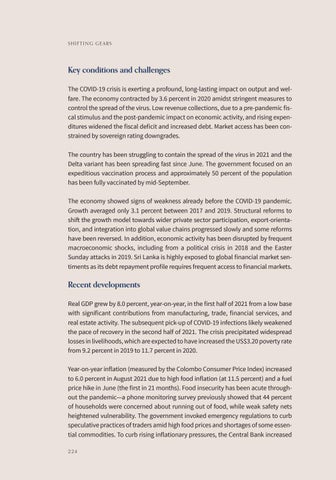shifting gears
Key conditions and challenges The COVID-19 crisis is exerting a profound, long-lasting impact on output and welfare. The economy contracted by 3.6 percent in 2020 amidst stringent measures to control the spread of the virus. Low revenue collections, due to a pre-pandemic fiscal stimulus and the post-pandemic impact on economic activity, and rising expenditures widened the fiscal deficit and increased debt. Market access has been constrained by sovereign rating downgrades. The country has been struggling to contain the spread of the virus in 2021 and the Delta variant has been spreading fast since June. The government focused on an expeditious vaccination process and approximately 50 percent of the population has been fully vaccinated by mid-September. The economy showed signs of weakness already before the COVID-19 pandemic. Growth averaged only 3.1 percent between 2017 and 2019. Structural reforms to shift the growth model towards wider private sector participation, export-orientation, and integration into global value chains progressed slowly and some reforms have been reversed. In addition, economic activity has been disrupted by frequent macroeconomic shocks, including from a political crisis in 2018 and the Easter Sunday attacks in 2019. Sri Lanka is highly exposed to global financial market sentiments as its debt repayment profile requires frequent access to financial markets.
Recent developments Real GDP grew by 8.0 percent, year-on-year, in the first half of 2021 from a low base with significant contributions from manufacturing, trade, financial services, and real estate activity. The subsequent pick-up of COVID-19 infections likely weakened the pace of recovery in the second half of 2021. The crisis precipitated widespread losses in livelihoods, which are expected to have increased the US$3.20 poverty rate from 9.2 percent in 2019 to 11.7 percent in 2020. Year-on-year inflation (measured by the Colombo Consumer Price Index) increased to 6.0 percent in August 2021 due to high food inflation (at 11.5 percent) and a fuel price hike in June (the first in 21 months). Food insecurity has been acute throughout the pandemic—a phone monitoring survey previously showed that 44 percent of households were concerned about running out of food, while weak safety nets heightened vulnerability. The government invoked emergency regulations to curb speculative practices of traders amid high food prices and shortages of some essential commodities. To curb rising inflationary pressures, the Central Bank increased 224




